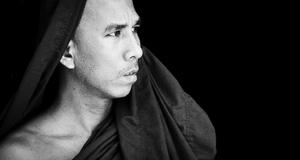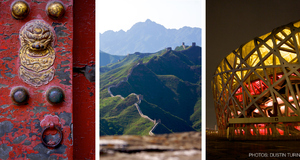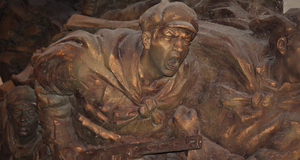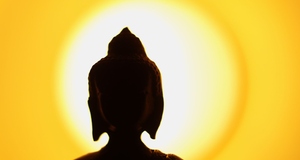The Dalai Lama, Buddhism, and Tibet: Reflecting on a Half-Century of Change
By
2010, Vol. 2 No. 04 | pg. 2/2 | « The current Dalai Lama has opened up his culture unlike any other one has. When he decided to pursue his international strategy, he ended up becoming a wide known international figure, and this way he ended the isolationism in Tibet, which was a main characteristic of this country in its whole history. After visits to Europe and the United States, “the Dalai Lama’s overall impression of the west firmly convinced him that democracy was a good thing, and this has led to many of the changes made to the Tibetan government in exile, which is now run on democratic principles.”17 However, even though the government is now democratic, Tibetans still see him as the same Bodhisattva with divine attributes, and their faith in him is as strong as ever. His status in world politics is unique, and it is admirable the way he manages to combine spirituality with politics in an impressive way.”18 The opening of Tibetan culture to the world also had the effect of spreading Buddhism as it appealed to numerous western people. “The Tibetan Diaspora has forced thousands of eminent lamas to leave their country, with the knowledge of the philosophy and meditative practices of Buddhism attracting large numbers of followers.”19 The migration of Buddhist monks and practitioners has made this religion known to people throughout the world, and is spreading with increasing popularity. “Tibetan spiritual ideas are now enclosed within a religious and social structure consisting of exiled Tibetan monks, newly ordained Western monks and nuns, and an assorted array of non-monastic lay practitioners. Such communities can be found all over the western world.”20 It seems that the more Tibetan Buddhism is destroyed in Tibet, the more it seems to spread all over the world.However, in Tibet a Buddhist revival has also taken place. Tibetan monks and nuns have assumed a prominent role in antigovernment political dissidence, and are becoming more active in bringing their religion back to life. This has consequently created a new wave of nationalism among Tibetans. “Their national identity remains a potent cultural force, and its vitality is powerfully supported by the ongoing revival of traditional Tibetan religious activity.”21 This all has resulted from the rejection of Chinese domination combined with the ideal of Tibetan autonomy, and the Dalai Lama has helped shape his beliefs with his efforts to bring happiness back to Tibetan people. “The spirit of nonviolence is very much relevant in today’s world to resolve conflict, and I consider nonviolent action is the manifestation and expression of compassion. We should not consider this a sign of weakness but of strength. So long as human intelligence exists there will always be contradiction, and logically the best way to solve this is through nonviolent action, dialog.”22 The previous words, taken from a speech by the Dalai Lama, embody how he advocates peace in a beautiful way, and this explains why his policies attract so many people and are so appealing to the international community. In short, the Dalai Lama’s policies that arose in response to China’s dominance over Tibet brought several positive changes such as the democratization of Tibet’s government, the end of isolationism, the spread and revival of Tibetan Buddhism, the newfound international interest in Tibet, the rise of nationalism among Tibetans, and the shift of the Dalai Lama from local ruler to international figure. Certainly Tibet will never be the same again, but we do not want it to be. Dalai Lama
“When he is in exile, he is independent. Many of the free countries can thus support him in his struggle for the liberation of the Tibetan people.”23 If all those unfortunate things had not happened to Tibet, it probably would have been better for them, but also the beneficial changes that came in consequence to that would not have happened. Because of all the reasons stated above, we can say that Tibetan Buddhism not only survived a violent invasion by the Chinese people, it was also strengthened by it; and the Dalai Lama not only survived an exile, but was benefited by it. ReferencesBishop, Peter. Dreams of Power: Tibetan Buddhism and the Western Imagination. London: The Athlone Press. 1993. Chhaya, Mayank. Dalai Lama: Man, Monk, Mystic. New York: Doubleday, 2007. Dalai Lama. My Land and My People. New York: McGraw-Hill Book Company, Inc., 1962. Farrer-Halls, Gill. The World of the Dalai Lama. Wheaton: Godsfield Press, 1998. Goldstein, Melvin C. The Snow Lion and The Dragon: China, Tibet, and the Dalai Lama. Berkeley and Los Angeles: University of California Press, 1997. Goldstein, Melvyn C. and Kapstein, Matthew T. Kapstein. Buddhism in Contemporary Tibet: Religious Revival and Cultural Identity. Berkeley and Los Angeles: University of California Press, 1998. Hart Strober, Deborah and Strober, Gerald S. His Holiness the Dalai Lama: The Oral Biography. New Jersey: John Wiley & Sons, Inc., 2005. Powers, John. Introduction to Tibetan Buddhism. Ithaca: Snow Lion Publications, 2007. Roy Burman, Bina. Religion and Politics in Tibet. New Delhi: Vikas Publishing House PVT LTD, 1979. Shen, Tsung-Lien and Liu, Shen-Chi. Tibet and the Tibetans. Stanford: Stanford University Press, 1953. Endnotes1.) Farrer-Halls, Gill. The World of the Dalai Lama. Wheaton: Godsfield Press, 1998. (p.41) 2.) Powers, John. Introduction to Tibetan Buddhism. Ithaca: Snow Lion Publications, 2007. (p.188) 3.) Dalai Lama. My Land and My People. New York: McGraw-Hill Book Company, Inc., 1962. (p.51) 4.) Ibid (p.21) 5.) Ibid (p.59) 6.) Powers, John. Introduction to Tibetan Buddhism. Ithaca: Snow Lion Publications, 2007. (p.198) 7.) Farrer-Halls, Gill. The World of the Dalai Lama. Wheaton: Godsfield Press, 1998. (p.33) 8.) Roy Burman, Bina. Religion and Politics in Tibet. New Delhi: Vikas Publishing House PVT LTD, 1979. 9.) Powers, John. Introduction to Tibetan Buddhism. Ithaca: Snow Lion Publications, 2007. (p.205) 10.) Ibid. (p.207) 11.) Goldstein, Melvin C. The Snow Lion and The Dragon: China, Tibet, and the Dalai Lama. Berkeley and Los Angeles: University of California Press, 1997. (p.63) 12.) Goldstein, Melvyn C. and Kapstein, Matthew T. Kapstein. Buddhism in Contemporary Tibet: Religious Revival and Cultural Identity. Berkeley and Los Angeles: University of California Press, 1998. 13.) Goldstein, Melvin C. The Snow Lion and The Dragon: China, Tibet, and the Dalai Lama. Berkeley and Los Angeles: University of California Press, 1997. (p.69) 14.) Hart Strober, Deborah and Strober, Gerald S. His Holiness the Dalai Lama: The Oral Biography. New Jersey: John Wiley & Sons, Inc., 2005. (p.148) 15.) Chhaya, Mayank. Dalai Lama: Man, Monk, Mystic. New York: Doubleday, 2007. 16.) Goldstein, Melvyn C. and Kapstein, Matthew T. Kapstein. Buddhism in Contemporary Tibet: Religious Revival and Cultural Identity. Berkeley and Los Angeles: University of California Press, 1998. (p.14) 17.) Farrer-Halls, Gill. The World of the Dalai Lama. Wheaton: Godsfield Press, 1998. (p.92) 18.) Halls, Gill. The World of the Dalai Lama. Wheaton: Godsfield Press, 1998. (p.64) 19.) Powers, John. Introduction to Tibetan Buddhism. Ithaca: Snow Lion Publications, 2007. (p.190) 20.) Bishop, Peter. Dreams of Power: Tibetan Buddhism and the Western Imagination. London: The Athlone Press. 1993. (p.17) 21.) Goldstein, Melvyn C. and Kapstein, Matthew T. Kapstein. Buddhism in Contemporary Tibet: Religious Revival and Cultural Identity. Berkeley and Los Angeles: University of California Press, 1998. 22.) Halls, Gill. The World of the Dalai Lama. Wheaton: Godsfield Press, 1998. (p.54) 23.) Hart Strober, Deborah and Strober, Gerald S. His Holiness the Dalai Lama: The Oral Biography. New Jersey: John Wiley & Sons, Inc., 2005. (p.52) Suggested Reading from Inquiries Journal
Inquiries Journal provides undergraduate and graduate students around the world a platform for the wide dissemination of academic work over a range of core disciplines. Representing the work of students from hundreds of institutions around the globe, Inquiries Journal's large database of academic articles is completely free. Learn more | Blog | Submit Latest in History |


















